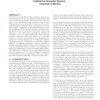502 search results - page 88 / 101 » Principal Component Analysis for Sparse High-Dimensional Dat... |
PAMI
2008
13 years 8 months ago
2008
This paper describes methods for recovering time-varying shape and motion of nonrigid 3D objects from uncalibrated 2D point tracks. For example, given a video recording of a talkin...
SIGDIAL
2010
13 years 6 months ago
2010
A central problem in Interactive Question Answering (IQA) is how to answer Follow-Up Questions (FU Qs), possibly by taking advantage of information from the dialogue context. We a...
ICPR
2006
IEEE
14 years 9 months ago
2006
IEEE
Tracking multiple interacting objects represents a challenging area in computer vision. The tracking problem in general can be formulated as the task of recovering the spatio-temp...
SIGMOD
2004
ACM
14 years 8 months ago
2004
ACM
The detection of correlations between different features in a set of feature vectors is a very important data mining task because correlation indicates a dependency between the fe...
PCM
2007
Springer
14 years 2 months ago
2007
Springer
The two-dimensional Principal Component Analysis (2DPCA) is a robust method in face recognition. Much recent research shows that the 2DPCA is more reliable than the well-known PCA ...

